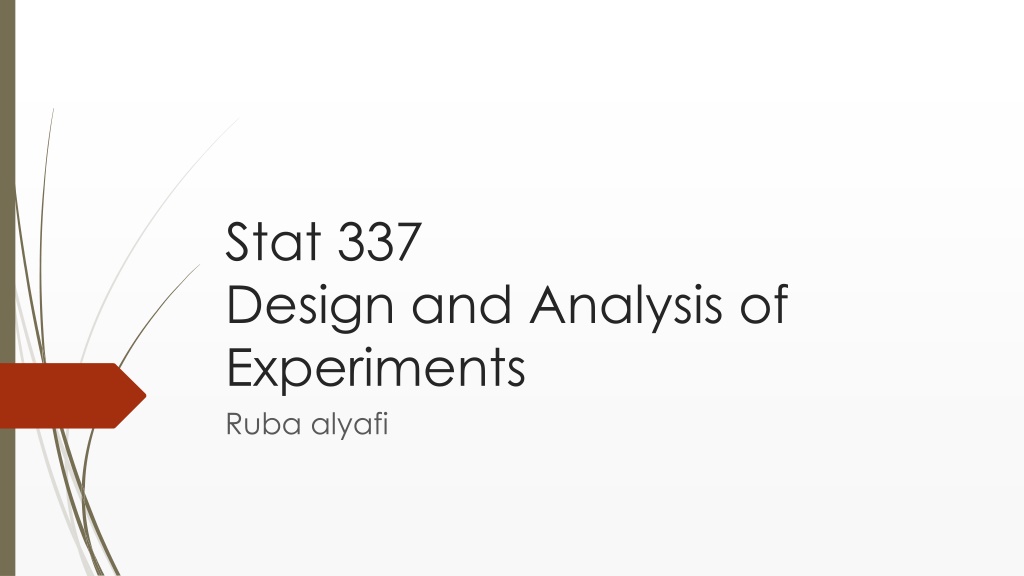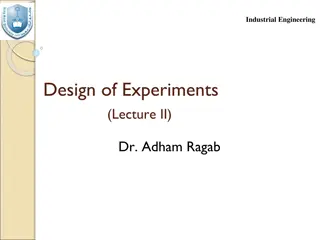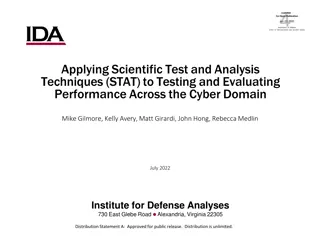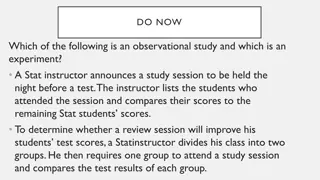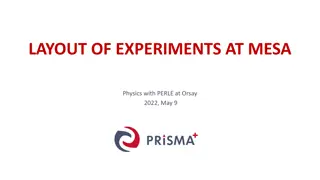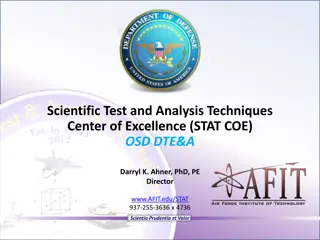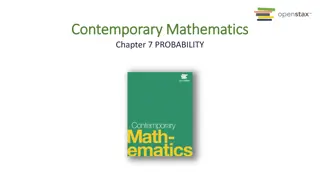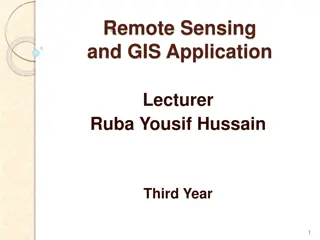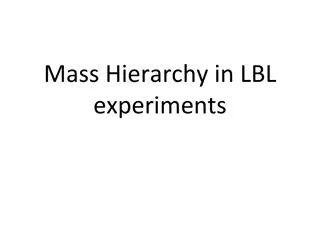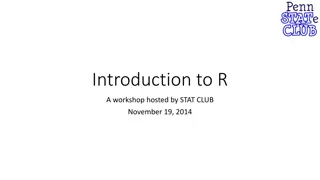Design and Analysis of Experiments in STAT 337 with Ruba Alyafi
Investigate the principles of experimental design, randomization, replication, and blocking in the context of STAT 337 with instructor Ruba Alyafi. Explore topics such as sampling distributions, point estimators, population inference, and more through practical applications and assignments. Dive into the world of statistical analysis to draw objective conclusions from experimental data.
Download Presentation

Please find below an Image/Link to download the presentation.
The content on the website is provided AS IS for your information and personal use only. It may not be sold, licensed, or shared on other websites without obtaining consent from the author. Download presentation by click this link. If you encounter any issues during the download, it is possible that the publisher has removed the file from their server.
E N D
Presentation Transcript
Stat 337 Design and Analysis of Experiments Ruba alyafi
Instructor: Ruba Alyafi Office: 3rd f-66 Building #5, E-mail: ralyafi@ksu.edu.sa Recommended Books: Design and Analysis of Experiments, D. C. Montgomery, Wiley and Sons, Course Scope Contents: . - . ( - . : - - : - ) - . . . . .
Assignments and Tests: Will be given during the classes 10 marks Midterm test I 25 marks Midterm test II 25 marks Final Exam As scheduled 40 marks Attendance: Student missing more than 25% of the total class hours won't be allowed to write the final exam.
Introduction Investigators perform experiments in virtually all fields of inquiry, usually to discover something about a particular process or system. This book is about planning and conducting experiments and about analyzing the resulting data so that valid and objective conclusions are obtained. The three basic principles of experimental design are randomization, replication, and blocking. Please read page 12 and 13
Chapter 1:Basic Statistical Method In this chapter, we consider experiments to compare two conditions (sometimes called treatments). These are often called simple comparative experiments. We will refer to the two different formulations as two treatments or as two levels of the factor. The concepts of expected value and variance: Please see page 29 30
1.1Sampling and Sampling Distributions Random Samples, Sample Mean, and Sample Variance. The objective of statistical inference is to draw conclusions about a population using a sample from that population. Properties of the Sample Mean and Variance. The sample mean ? is a point estimator of the population mean , and the sample variance ?2 is a point estimator of the population variance ?2. In general, an estimator of an unknown parameter is a statistic that corresponds to that parameter. Note that a point estimator is a random variable. A particular numerical value of an estimator, computed from sample data, is called an estimate. Several properties are required of good point estimators. Two of the most important are the following: 1- unbiased. 2- minimum variance. Read page 31
The Normal and Other Sampling Distributions. Often we are able to determine the probability distribution of a particular statistic if we know the probability distribution of the population from which the sample was drawn. The probability distribution of a statistic is called a sampling distribution. We will now briefly discuss several useful sampling distributions. One of the most important sampling distributions is the normal distribution
An important sampling distribution that can be defined in terms of normal random variables is the chi-square. If ?1, ?2, . . . , ??are normally and independently distributed random variables with mean 0 and variance 1, abbreviated NID(0, 1), then the random variable follows the chi-square distribution with k degrees of freedom. As an example of a random variable that follows the chi-square distribution, suppose that ?1, ?2, . . . , ??is a random sample from an N( ,?2) distribution. Then If z and?? respectively, the random variable 2 are independent standard normal and chi-square random variables, follows the t distribution with k degrees of freedom.
If ?1, ?2, . . . , ??is a random sample from an N(,?2) distribution, then the quantity is distributed as t with n -1 degrees of freedom. The final sampling distribution that we will consider is the F distribution. If ?? 2 and 2 are two independent chi-square random variables with u and v degrees of ?? freedom, respectively, then the ratio follows the F distribution with u numerator degrees of freedom and v denominator degrees of freedom. As an example of a statistic that is distributed as F, suppose we have two independent normal populations with common variance ?2. ?11, ?12, . . . , ?1?is a random sample of n1observations from the first population, and if ?21, ?22, . . . , ?2? is a random sample of n2 observations from the second, then
1.2Inferences About the Differences in Means, Randomized Designs
Hypothesis Testing Please read pages 36-40 Two kinds of errors may be committed when testing hypotheses. If the null hypothesis is rejected when it is true, a type I error has occurred. If the null hypothesis is not rejected when it is false, a type II error has been made. The probabilities of these two errors are given special symbols
The Two-Sample t-Test Example 1.1: An engineer is studying the formulation of a Portland cement mortar. He has added a polymer latex emulsion during mixing to determine if this impacts the curing time and tension bond strength of the mortar. The experimenter prepared 10 samples of the original formulation and 10 samples of the modified formulation. We will refer to the two different formulations as two treatments or as two levels of the factor formulations. When the cure process was completed, the experimenter did find a very large reduction in the cure time for the modified mortar formulation. Then he began to address the tension bond strength of the mortar. If the new mortar formulation has an adverse effect on bond strength, this could impact its usefulness. The tension bond strength data from this experiment are shown in the Table
The Use of P-Values in Hypothesis Testing: see page 40 output:
Confidence Intervals is a 100(1- ) percent confidence interval for?1 ?2. The actual 95 percent confidence interval estimate for the difference in mean tension bond strength for the formulations of Portland cement mortar is found by
The Case Where ?1 2 and ?2 2 Are Known
The Case Where ?1 2 ?2 2 lets say we have the following data
Because the equal variance assumption is not appropriate here, we will use the two sample t-test described in this section to test the hypothesis of equal means. The number of degrees of freedom are calculated output
Comparing a Single Mean to a Specified Value Please read page 51
The Paired Comparison Problem page 53-57 We may write a statistical model that describes the data from this experiment as Example:
Testing ?0:?1= ?2 is equivalent to testing This is a single-sample t-test. The test statistic for this hypothesis is is the sample mean of the differences and is the sample standard deviation of the differences.
Decision: and because t-calculated 0.26 is less than t-table 2.262, we cannot reject the hypothesis ?0 that is, there is no evidence to indicate that the two tips produce different hardness readings. Output:
Confidence interval: We may also express the results of this experiment in terms of a confidence interval on ?1 ?2Using the paired data, a 95 percent confidence interval on ?1 ?2is
Inferences About the Variances of Normal Distributions page 57-59 note that:
Confidence interval: Example:
Chapter 2: E x p e r i m e n t s w i t h a S i n g l e F a c t o r : T h e A n a l y s i s o f Va r i a n c e 2.1 analysis of variance: page 68-69 Suppose we have a treatments or different levels of a single factor that we wish to compare. The observed response from each of the a treatments is a random variable. The data would appear as in Table 3.2. An entry in Table 3.2 (e.g., yij) represents the jth observation taken under factor level or treatment i. There will be, in general, n observations under the ith treatment.
Models for the Data. We will find it useful to describe the observations from an experiment with a model. One way to write this model is Mean model: An alternative way to write a model for the data is to define In this form of the model,? is a parameter common to all treatments called the overall mean, and ?? is a parameter unique to the ith treatment called the ith treatment effect. This model is usually called the effects model. For hypothesis testing, the model errors are assumed to be normally and independently distributed random variables with mean zero and variance ?2. The variance ?2 is assumed to be constant for all levels of the factor.This implies that the observations
2.2 Analysis of the Fixed Effects Model page 70- In this section, we develop the single-factor analysis of variance for the fixed effects model.Recall that ??.represents the total of the observations under the ith treatment. Let ??.representthe average of the observations under the ith treatment. Similarly, let ?..represent the grand total of all the observations and ?.. represent the grand average of all the observations. Expressed symbolically, where N = an is the total number of observations. We are interested in testing the equality of the a treatment means. The appropriate hypotheses are An equivalent way to write the above hypotheses is in terms of the treatment effects
Statistical Analysis page 73-77 Where We reject the null hypothesis and conclude that there are differences in the treatment means if
Estimation of the Model Parameters page 78 We now present estimators for the parameters in the single-factor model Therefore, a 100(1-? ) percent confidence interval on the ith treatment mean ?? and the difference in any two treatments means ?? ?? , respectively are
